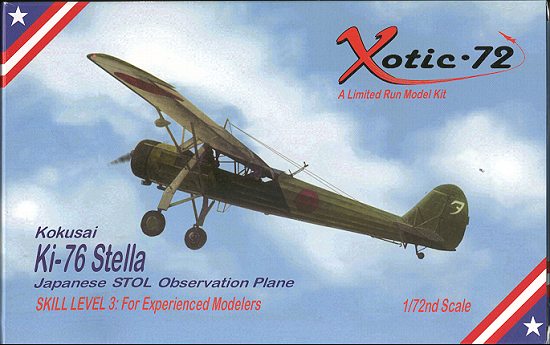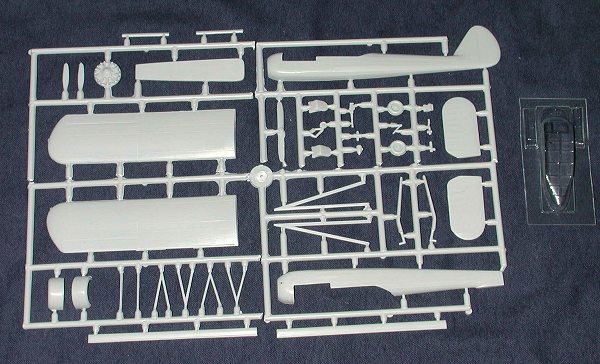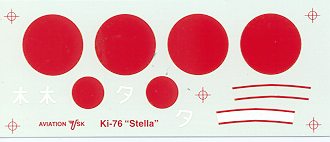
|
KIT: |
Xotic 72 1/72 Ki-76 'Stella' |
|
KIT # |
AU 2024 |
|
PRICE: |
$17.95 from Aviation USK Nebraska |
|
DECALS: |
Three aircraft |
|
REVIEWER: |
|
|
NOTES: |
Short run with etched fret and vac canopy |

|
HISTORY |
Though it appears to be a Japanese copy of the Fieseler Fi-156 'Storch', it is not. Design work on the Ki-67 began nearly a year before the Japanese obtained a Storch from the Germans. This work began in 1940 after the Japanese saw how successful the Storch was in artillery spotting and liaison duties. The aircraft was patterned after the German aircraft but used a 310 hp Hitachi radial in place of the 240 hp Argus in-line used by the Storch. An addition design change was the use of Fowler vice slotted flaps to achieve stol performance. These flaps were synchronized with variable incidence horizontal tail surfaces for greater lift.
The aircraft was very easy to fly so even pilots with limited experience could successfully fly the plane. In a fly-off against the Fieseler aircraft, the Ki-76 outperformed it in every respect except for landing distance, which was a bit longer. With trials complete in late 1942 it was put into production as the Army Type 3 Liaison aircraft. The allies gave it the name 'Stella'.
Late in 1943, the aircraft was modified for use aboard the Akitsu Maru as an ASW patrol plane and fitted with two 60 kg depth charges. 7 aircraft were normally embarked but not really successful in that role and later replaced by autogiro aircraft instead. An unknown number were built and none have survived the war. Frankly, there are not even many photos of the plane as it was one of those mundane and unexciting aircraft that were in every theater of operations of the time.
|
THE KIT |

This is one of the newer Xotic-72 kits and such shows improvements over earlier kits. Basically, the level of molding is a bit higher with some smaller sprue gates. Detailing is still very fine and the plastic on the hard side. Any sanding that will be needed will undoubtedly quickly destroy any engraved detail.
 The kit is what I'd
call a 'strutter'. That's because it had a lot of struts, both for the wing and
the landing gear. The vac canopy is quite clear and attaching the wings to this
part will be interesting to say the least. An etched brass fret is included for
things like the flap tracks, some engine bits, a couple of the wing struts, and
interior parts. I know that a lot of people don't like the two dimensional
aspect of etched brass, but in this case it should work out well.
The kit is what I'd
call a 'strutter'. That's because it had a lot of struts, both for the wing and
the landing gear. The vac canopy is quite clear and attaching the wings to this
part will be interesting to say the least. An etched brass fret is included for
things like the flap tracks, some engine bits, a couple of the wing struts, and
interior parts. I know that a lot of people don't like the two dimensional
aspect of etched brass, but in this case it should work out well.
 Instructions are
very well done with a parts diagram and several construction steps. It shows the
only optional bit, a choice between a wooden and metal prop. Personally, I'll
take the wooden one as the metal prop has separate blades and hub! The
instructions recommend installing a spar through the cockpit to hold the wings
in place. I fully agree as the wings are single piece moldings and a bit heavy,
though the struts will help support this weight. Decals are given for three
aircraft. Two are in dark green over light grey and the third is overall orange
with a black forward section. The instructions state that this could have been
aluminum in place of the orange and dark green in place of the black. There are
no color photos available of this plane so one must do a best guess. Decals are
well printed and seem to be admirably thin.
Instructions are
very well done with a parts diagram and several construction steps. It shows the
only optional bit, a choice between a wooden and metal prop. Personally, I'll
take the wooden one as the metal prop has separate blades and hub! The
instructions recommend installing a spar through the cockpit to hold the wings
in place. I fully agree as the wings are single piece moldings and a bit heavy,
though the struts will help support this weight. Decals are given for three
aircraft. Two are in dark green over light grey and the third is overall orange
with a black forward section. The instructions state that this could have been
aluminum in place of the orange and dark green in place of the black. There are
no color photos available of this plane so one must do a best guess. Decals are
well printed and seem to be admirably thin.
|
CONCLUSIONS |
From what I know, this is the ONLY kit of this plane around in injected plastic. It doesn't seem to be a difficult build, but one that needs to be done carefully to endure proper fit of all the bits. I can tell you from having built a Storch, that these spindly planes look pretty cool when sitting next to a sleek fighter. As the box says, recommended only for experienced builders.
|
REFERENCES |
Japanese Aircraft of the Pacific War, RJ Francillon, 1979
Review kit courtesy of the fine folks at Aviation USK Nebraska. Thank you for your support.
If you would like your product reviewed fairly and quickly by a site that has well over 150,000 visitors a month, please contact me or see other details in the Note to Contributors.